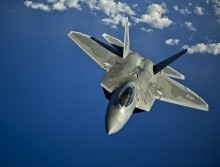
If only they had had more time. Photo Courtesy of U.S. Air Force photo/Tech. Sgt. Michael Holzworth.
2014. The year the world changed. Maybe for good. Definitely for bad. Of course, by now you know what happened in the months after Iran tested that nuclear weapon. The oil prices that surged as Middle East tensions hit an all-time high. The general collapse of the global economy after the spike in the cost of fuel—used for cars commuting to work, trucks carrying food and construction supplies, commercial airlines carrying businessmen and so on. No need to go into any more detail about what you know, even if you may have forgotten after The Event.
But what you may not know is what led up to the horrors of October 8. So now that we have the time, after we ran out of time, let me tell you what happened behind the scenes.
In the weeks leading up to October 8, the Israeli Mossad spy agency informed the CIA of relatively high amounts of chatter between Iran and agents in South America. It wasn’t totally unusual. The Iranians had been developing a terrorist infrastructure in the region for decades.
It was quite brilliant. Rather than move terrorists into the continent and draw attention to their actions, the Iranians moved fundraisers and leaders from the Hezbollah terror group there. They were experts in building terror groups. And build they did.
Venezuela was the perfect place to develop the model, but it soon spread. The shocking upsurge in drug crime in Mexico gave the real opportunity. Hezbollah has long worked in the drug underworld, and their connections were put to good use.
Drug lords in Mexico, who had effectively built miniature kingdoms independent of Mexican authority, were indebted to Hezbollah and Iran.
Weapons, communications equipment, tactical training, and tunnel development for moving drugs and people had all been given—at discounted rates.
The Iranians weren’t helping the drug lords out of charity, however. They planned to cash in eventually. And they really did.
And that brought us to October 1, 2014. CIA agents began picking up communications regarding Venezuela. Apparently, a Cuban ship of some unspecified cargo had left an unknown Venezuelan port and was traveling to Mexico. The whole arrangement sounded like a major drug move.
At least that’s what the US thought. The Israelis recommended intercepting the ship, but US President Barack Obama’s administration wouldn’t hear of it. A grandiose undercover operation was in place to bust the Mexican drug trade wide open. The US was quietly prepping for United Nations intervention. All they needed was hard evidence, and this drug bust was the perfect opportunity.
So the satellites watched. They watched the ship travel through the Caribbean, past Central America and into Mexico. They watched the cargo get unloaded into a secret Mexican port used by drug smugglers. They watched it move on trucks to a warehouse not far from the coast.
And then they—the CIA and not just their satellites—finally moved. Mexican police, with military backup and CIA advisors, stormed the warehouse….
And it blew up. A massive explosion that lit up the night sky. And the warehouse was gone.
It would be weeks before the tunnels were discovered. The tunnels that led to another warehouse more than two miles away. The warehouse near backroads that carried the secret cargo deep into Mexico towards the US border.
Of course, all of that was lost amidst the immediate “crisis” with North Korea. A surprise North Korean missile launch was set for October 7, and some feared a potential nuclear test fire. The Americans were focused and their South Korean allies were nervous. The North Koreans?
The North Koreans… were bluffing. The radioactive signatures in North Korea were minor for a reason, and the missile was benign. Well, as benign as a giant rocket with a sizable warhead of conventional explosives can be. But the missile’s target was the southern Pacific Ocean, not South Korea.
In the meantime, the distraction from their North Korean allies gave Hezbollah the cover they needed. Their package was the final piece in a months-long puzzle. The total operation had taken years to put into place. And on October 8, they were ready.
As the moon gradually set into an eclipse that covered the Western US and the northwestern corner of Mexico, a US military base got a spike of radioactive signals coming from across the border.
The trouble was that most of the American nuclear surveillance equipment was still in Asia, watching for trouble from the Koreans. So the detection in Mexico came late.
Shortly thereafter, the heat signals reached unusually high levels of detection, coming from the same area. Additional American satellites were immediately called into action and US fighter jets began emergency launch.
If it hadn’t have been for so many military budget cuts, the US might have detected the nuclear missile in northwestern Mexico sooner. It was a sizable rocket and took some time to warm up. Despite Hezbollah’s surprisingly effective hiding methods—honed in wars with Israel—it may have been possible for the US Air Force to stop the launch, if they had had more time.
More time.
It was what the Americans had thought their breakthrough nuclear deal with Iran would buy for everyone.
More time.
It was what the Americans had asked from the Israelis when Prime Minister Benjamin Netanyahu was calling for a preemptive military strike on Iran’s nuclear facilities the summer before.
More time.
It’s what thousands of people thought they would have on October 9, 2014.
More time.
It’s what we always want.
But at some time, we run out of time. And then “more time” is no longer a request. It’s a lament.
(By Joshua Spurlock, www.themideastupdate.com, November 10, 2014)
